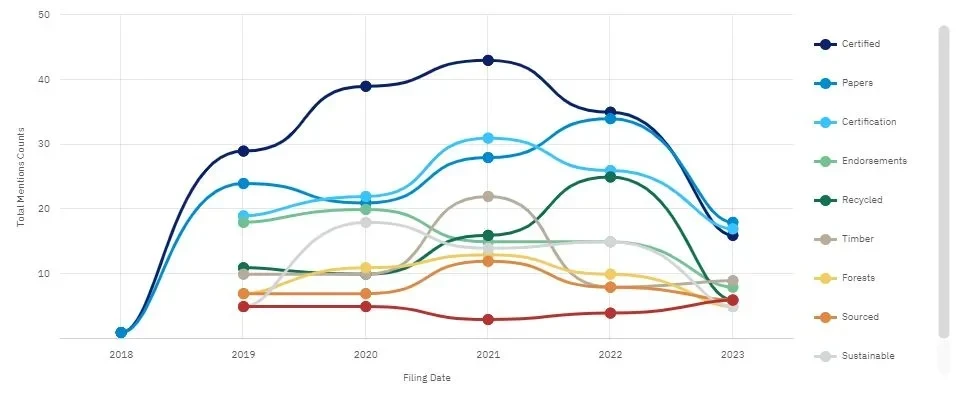The Programme for the Endorsement of Forest Certification (PEFC) tells Just Style fashion brands are not advertising their certifications on labels, which is “a “real missed opportunity” for the many brands that are using forest-sourced materials in their supply chains.

Apparel is not the most obvious example when it comes to naming products made from forest-sourced materials with paper and packaging more likely to take the top spots.
It’s common for consumers to see paper packaging with a Programme for the Endorsement of Forest Certification (PEFC) label that clearly shows it has been sourced from a sustainable forest, however these certifications on clothing are rare.
Despite this, a recent PEFC event, held alongside the Textile Exchange conference in London revealed that just under 7% of all raw materials used in textile manufacturing originate from trees.
PEFC’s market engagement manager and textile programme lead Julia Kozlik told Just Style the textile sector uses almost twice as much raw material from trees as it does from wool, in terms of quantity used.
Man-made cellulosic fibres (MMCFs) predominantly originate from forests, so its important that fashion brands understand the importance of sustainable forest management in preventing deforestation and protecting trees.
That’s before we even get started on the amount of paper and cardboard packaging used in the fashion sector, particularly as recent years have seen many brands stepping away from plastics as much as possible to boost their green credentials.
Kozlik says many brands have simply switched to paper-based packaging and consider this to be a sustainable alternative to plastic, but it’s important to consider whether any wood-based materials used are sustainably sourced.
“They need a responsible sourcing policy to make sure that everything they source comes from sustainably managed forests,” she says.
The PEFC sets national requirements for forests across the world, ensuring that local standards are tailored to each area’s unique cultural context and ecosystem. The standards are updated every five years to ensure that they keep up with the latest scientific consensus.
In July 2023, the PEFC published a white paper encouraging fashion brands to adopt responsible forest sourcing practices. This followed PEFC’s 2020 campaign raising awareness of the importance of sourcing from sustainably managed forests.
“By using tree-based textiles, the fashion industry can make a difference with their raw material sourcing choices,” Kozlik explains, adding: “Overall, the healthiness of our forests is very important. We really need healthy and thriving forests that continue absorbing the carbon, producing oxygen and filtering water.”
Kozlik cites the UN’s fashion charter, which says that sourcing all tree-based materials from forests that are managed sustainably can have a positive impact on deforestation and help lower the overall carbon footprint of apparel products.
“The fashion industry can make a difference with their material choices with their raw materials and sourcing choices,” Kozlik adds. She says that sustainable forest certification “definitely has a positive impact on the overall footprint” of a product.

Just Style joined the PEFC on a field trip to Swinley Forest in Ascot, UK, which is owned and managed by the Crown Estate, where we were able to see sustainable forest management in action. The site is part of Windsor Great Park and has both Forest Stewardship Council and PEFC certification.
We were lucky enough to witness almost the full cycle of life in the forest ranging from a fresh field of tree saplings that were just starting to grow to some much older trees being chopped ready to be made into chippings.
PEFC shared many examples of food and stationery packaging proudly displaying its certification logo, so that consumers can be confident that any forest-sourced materials in the products are from sustainably managed sources.
The fashion sector certainly has a way to go to catch up. Kozlik tells Just Style that currently there are no apparel brands advertising their PEFC certifications on labels, which seems like a real missed opportunity for the many brands which are using forest-sourced materials in their supply chains.
Apparel company filings mentioning PEFC-related terms since 2018

GlobalData’s filings data shows that mentions of PEFC-related terms, including ‘sustainable’, ‘forests’ and ‘sourced’ in apparel company filings increased in the last five years, although mentions peaked in 2021 and have trailed off ever since.
“We’re at the beginning of the journey,” Kozlik says, although she believes fashion brands are making a “positive shift” with awareness of sustainable forest certification growing in the sector.
“Brands now understand that those fibres aren’t just viscose – it’s wood-based fibre and it came from the forest,” she says, concluding: “In the last two years there’s been tremendous positive shift.”
Our signals coverage is powered by GlobalData’s Thematic Engine, which tags millions of data items across six alternative datasets — patents, jobs, deals, company filings, social media mentions and news — to themes, sectors and companies. These signals enhance our predictive capabilities, helping us to identify the most disruptive threats across each of the sectors we cover and the companies best placed to succeed.
Source from Just Style
Disclaimer: The information set forth above is provided by just-style.com independently of Alibaba.com. Alibaba.com makes no representation and warranties as to the quality and reliability of the seller and products.




